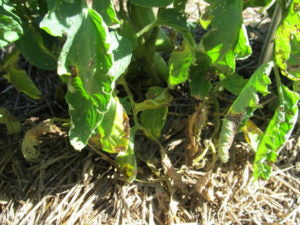Mid-summer, right as gardeners are getting used to the consistent rhythm of tender summer crop harvests, is also the time when diseases are most likely to strike some of our favorite nightshades - tomatoes and potatoes. With the recent news that late blight has been spotted early this year in Onondaga County, NY (and now confirmed by Cornell University's Plant Disease Diagnostic Clinic), today we're focusing on what Late Blight is, how to spot it and what to do if you find it in your garden.

What is late blight? Late blight was first discovered in the United States in the early 1840s and is the same disease that caused the Irish potato famine in the mid 1900s. It's a devastating disease that can affect and destroy the leaves, stems, fruits and tubers of potato and tomato plants.
How to spot late blight?
Late blight commonly affects both tomatoes and potatoes but looks a little different depending on the plant:
- Tomato Late Blight. The first symptoms to look for are irregularly shaped, watery, grey-green lesions on the leaves and stems, not bounded by leaf veins. Under humid conditions, the lesions can become brown and can grow a white, moldy-looking center (pathogen sporulation). As the disease develops, the lesions will enlarge, multiply, spread, and eventually, the leaves will shrivel and die. The tomato fruit can also be infected, developing circular greasy lesions, which can grow to cover the whole fruit.
See tomato late blight photos and more info at usablight.org.
- Potato Late Blight. Blackish, watery lesions occur on the leaves and a white, moldy-looking part (pathogen sporulation) can develop around the side of the lesions and on the underside of the leaf if it's humid. Purplish-brown lesions also develop on the surface of the potato tubors.
See potato late blight photos and more info at usablight.org
Two other diseases it's easy to confuse with late blight:

- Early Blight may sound devastating given its cousin's reputation, but it isn't necessarily so bad, and it's everywhere. Like late blight, plants will develop lesions, but they are often bounded by leaf veins and resemble little targets. Early blight spreads through water, and can also be an indication of over-watering. You can lessen the effects of early blight by pruning off and discarding affected leaves, mulching with a clean straw mulch, amending your soil and applying a foliar feed when the plants start to fruit.
- Septoria Leaf Spot consists of round, yellow or water-soaked spots on the undersides of leaves. They quickly emerge on leaf tops and turn to black or brown with tiny black dots in the center. Septoria doesn't cause lesions on fruit.
This Cornell poster will help you to distinguish between Late Blight, Early Blight and Septoria Leaf Spot.
How to prevent late blight? There are several actions you can take against this plant disease:
- Remove volunteer tomatoes and potatoes from the garden
- Improve air circulation via pruning and staking
- Keep plants dry. Water only in the morning and avoid overhead watering. Water the soil not foliage.
- Avoid handling plants when wet.
What to do if you identify late blight in your garden?
Late blight thrives in humid, wet conditions and can easily spread to your neighbors, and from home gardens to commercial operations. If you observe the disease in your garden you should contact your Local Cornell Cooperative Extension (CCE) for advice.
Remove the infected plants during the middle of a sunny day after leaves have dried, if possible. Don't compost any of the diseased plant material. Seal plants in garbage bags and leave them in the sun for a few days to kill plants and the pathogen quickly before placing in the trash.
More resources
- Cornell's Brochure on Late Blight
- Cornell University Tomato Disease Identification Key
- Youtube video on what to do if you find late blight in your garden
That's it growers. Stay vigilant and here's hoping for a healthy crop of tomatoes and potatoes this summer.





